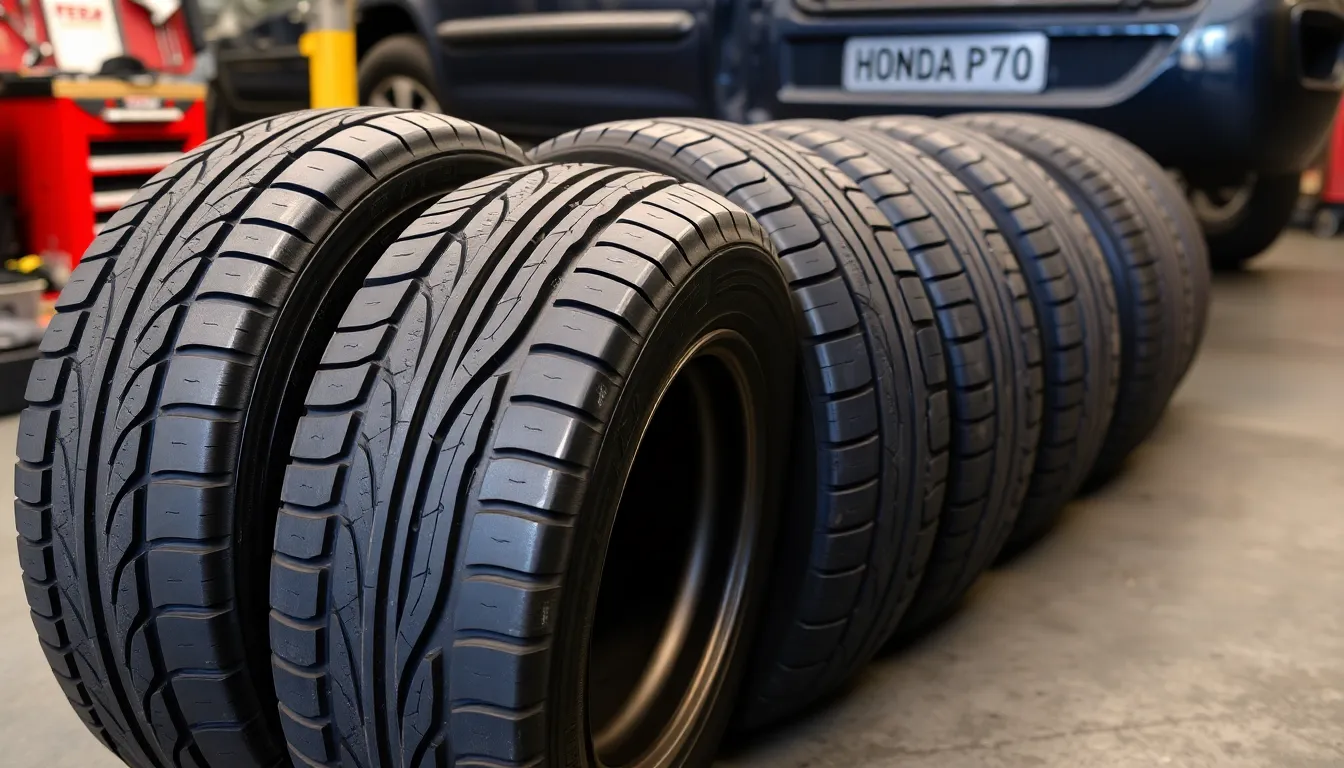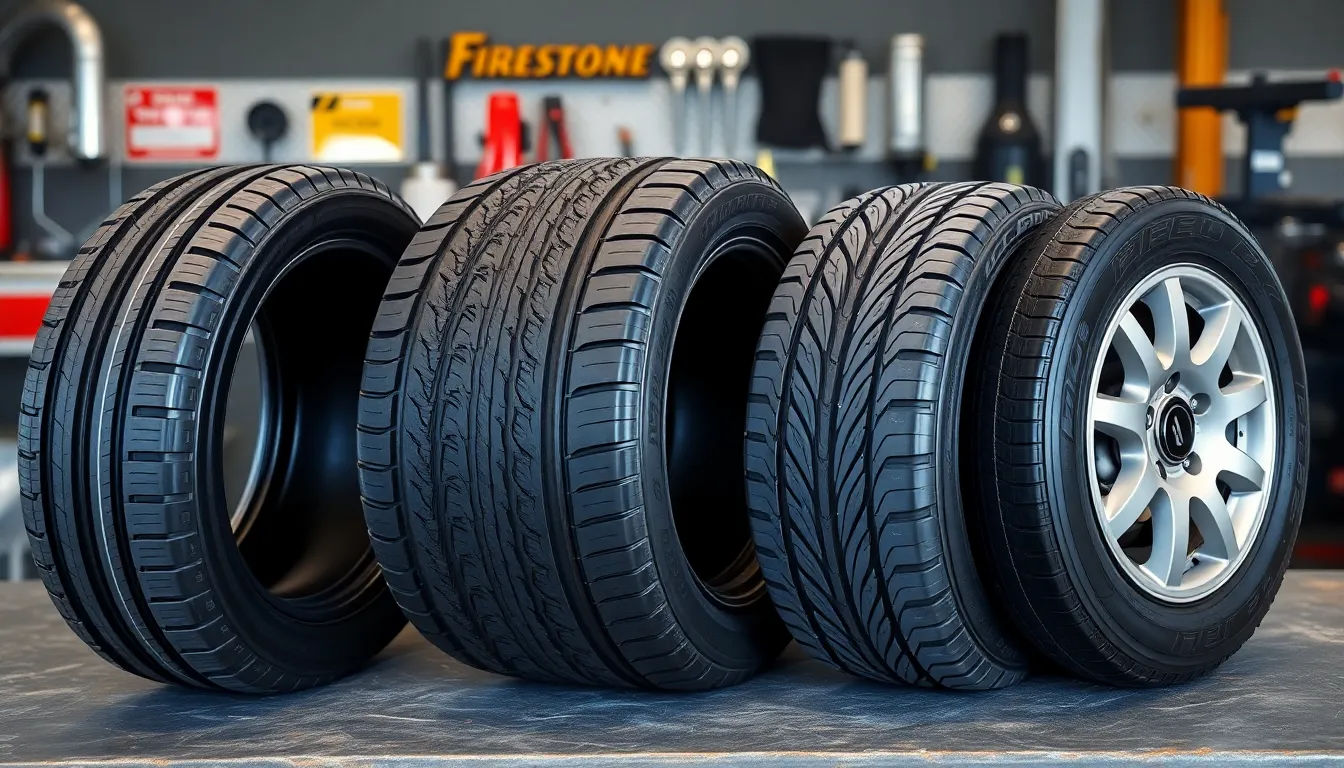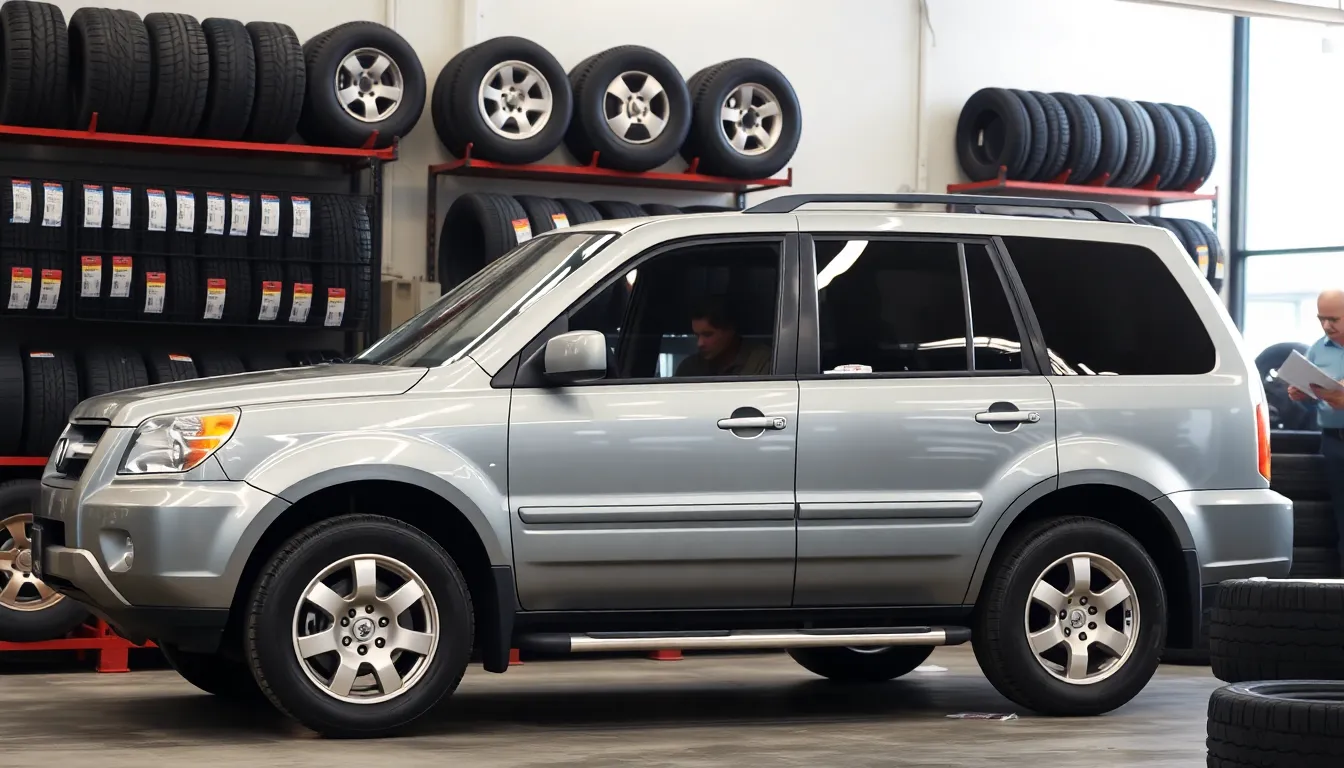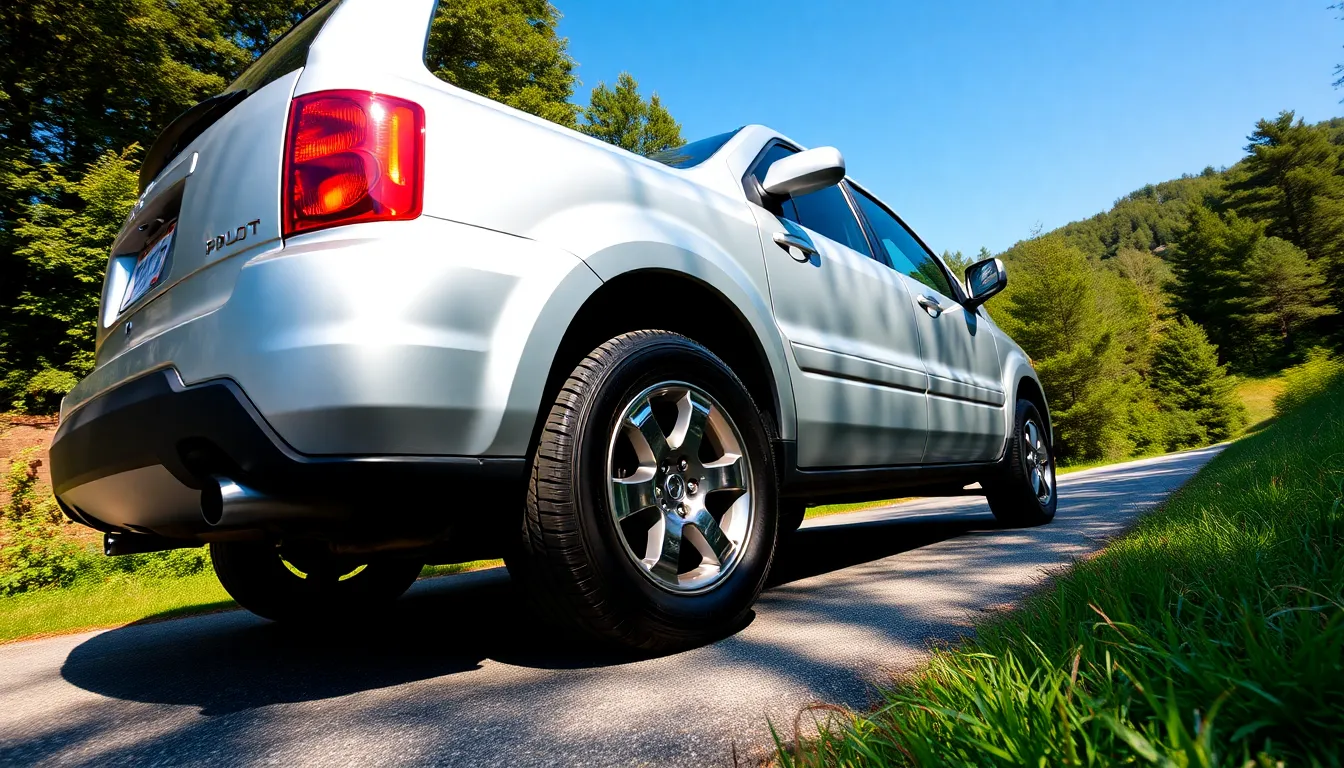Finding the right tire size for your 2006 Honda Pilot isn’t just about replacing what’s worn out – it’s about maximizing your SUV’s performance, safety, and fuel efficiency. We’ve all been there: standing in the tire shop wondering if we’re making the right choice while staring at confusing numbers and letters that determine how our vehicle handles the road.
Your 2006 Pilot came with exact tire specifications that Honda engineered for optimal performance, but understanding these numbers opens up possibilities for upgrades and replacements that could transform your driving experience. Whether you’re dealing with worn treads, seasonal changes, or simply want better performance, knowing your exact tire requirements saves you money and ensures you’re getting the most from your investment.
We’ll break down everything you need to know about 2006 Honda Pilot tire sizes, from decoding those cryptic sidewall markings to exploring upgrade options that won’t void your warranty or compromise safety.
Standard Tire Size for 2006 Honda Pilot
The 2006 Honda Pilot comes equipped with 245/70R16 tires as the factory standard size across all trim levels. Honda engineers selected this exact tire dimension to optimize the vehicle’s ride comfort, fuel economy, and load carrying capacity for family SUV applications.
Breaking down the 245/70R16 specification reveals important sizing details:
| Component | Measurement | Description |
|---|---|---|
| 245 | millimeters | Tire width from sidewall to sidewall |
| 70 | aspect ratio | Sidewall height as percentage of width |
| R | construction | Radial tire construction type |
| 16 | inches | Wheel rim diameter |
Our research confirms that Honda maintained consistent tire sizing across the EX and LX trim levels for the 2006 model year. Factory specifications indicate a tire pressure of 32 PSI for both front and rear positions under normal driving conditions.
Load index ratings for the standard 245/70R16 tires typically range from 107 to 111, supporting vehicle weights between 2,149 and 2,403 pounds per tire. Speed ratings commonly include S (112 mph) or T (118 mph) classifications, matching the Pilot’s intended use as a family transport vehicle.
Replacement tires maintaining the 245/70R16 size ensure proper speedometer calibration and preserve the vehicle’s original handling characteristics. We recommend verifying the exact load index and speed rating requirements on your driver’s side door jamb sticker before purchasing replacement tires.
Alternative wheel sizes became available through Honda’s accessory program, including 17-inch and 18-inch options that require corresponding tire size adjustments to maintain overall diameter specifications.
Understanding Tire Size Numbers and Specifications

We find that many 2006 Honda Pilot owners get confused by the alphanumeric code printed on their tire sidewalls. Reading these specifications correctly ensures you select replacement tires that maintain your vehicle’s performance characteristics.
Decoding the Tire Size Format
The tire size follows a standardized format: Tire Type/Width/Aspect Ratio/Construction Type/Rim Diameter/Load Index/Speed Rating. For the 2006 Honda Pilot’s P245/70R16 specification, each element provides crucial information about the tire’s dimensions and capabilities.
P indicates passenger vehicle designation, distinguishing it from light truck (LT) or commercial tire categories. The number 245 represents tire width measured in millimeters from sidewall to sidewall when mounted and inflated. 70 shows the aspect ratio, meaning the sidewall height equals 70% of the tire’s width measurement.
R designates radial construction where tire cords run perpendicular to the direction of travel. The final number 16 specifies the wheel rim diameter in inches that the tire fits.
Load Index and Speed Rating Explained
Load index appears as a numerical value following the rim diameter specification. For 2006 Honda Pilot tires, load index ratings typically range from 107 to 111, corresponding to maximum weight capacities between 2,149 and 2,403 pounds per tire.
Speed rating uses letter codes to indicate maximum safe operating speeds under optimal conditions. Common ratings for Honda Pilot applications include S (112 mph), T (118 mph), and H (130 mph). Honda engineers selected these ratings to exceed normal driving requirements while maintaining safety margins for emergency maneuvers.
| Load Index | Weight Capacity (lbs) | Speed Rating | Max Speed (mph) |
|---|---|---|---|
| 107 | 2,149 | S | 112 |
| 109 | 2,271 | T | 118 |
| 111 | 2,403 | H | 130 |
These specifications directly impact your vehicle’s load carrying capacity and speed capabilities, making proper selection essential for maintaining Honda’s original safety standards.
OEM Tire Specifications and Performance

Honda engineers specified multiple tire configurations for the 2006 Pilot to accommodate different trim levels and driving preferences. These original equipment manufacturer specifications ensure optimal vehicle performance while maintaining safety standards.
Original Equipment Manufacturer Requirements
The 2006 Honda Pilot utilizes five distinct OEM tire configurations depending on the exact trim level and wheel package selected. Base LX models feature 235/70R16 104S tires mounted on 6.5JJx16 ET45 wheels as the standard configuration. Higher trim levels incorporate 235/65R17 103T tires on 7Jx17 ET50 wheels for enhanced handling characteristics.
Performance oriented configurations include 255/60R17 103T tires paired with 7.5Jx17 ET47 wheels for improved road contact. Premium packages feature 235/60R18 102T tires on 7.5Jx18 ET47 wheels or 255/55R18 103H tires mounted on 8Jx18 ET45 wheels. Top tier configurations use 255/50R19 101H tires with 8Jx19 ET45 wheels for maximum aesthetic appeal and cornering precision.
| Tire Size | Load Rating | Speed Rating | Wheel Size | Offset |
|---|---|---|---|---|
| 235/70R16 | 104 | S (112 mph) | 6.5JJx16 | ET45 |
| 235/65R17 | 103 | T (118 mph) | 7Jx17 | ET50 |
| 255/60R17 | 103 | T (118 mph) | 7.5Jx17 | ET47 |
| 235/60R18 | 102 | T (118 mph) | 7.5Jx18 | ET47 |
| 255/55R18 | 103 | H (130 mph) | 8Jx18 | ET45 |
| 255/50R19 | 101 | H (130 mph) | 8Jx19 | ET45 |
Factory Tire Performance Characteristics
Balance and handling optimization drives the design philosophy behind each OEM tire specification for the 2006 Honda Pilot. Load ratings range from 101 to 104, corresponding to maximum weight capacities between 1,819 and 1,984 pounds per tire. Speed ratings vary from S to H classifications, accommodating maximum safe speeds from 112 mph to 130 mph depending on the exact tire configuration.
The 235/70R16 104S configuration provides maximum load capacity at 1,984 pounds per tire while maintaining a 112 mph speed rating for everyday family use. Larger diameter options like the 255/50R19 101H reduce load capacity to 1,819 pounds but increase the speed rating to 130 mph for enhanced performance driving. Each tire size maintains exact aspect ratios designed to preserve ride quality while accommodating different wheel diameters and visual preferences across trim levels.
Alternative Tire Size Options

We’ve documented several alternative tire sizes compatible with the 2006 Honda Pilot that expand beyond the standard configurations. These options allow customization while maintaining proper fitment and safety clearances.
| Tire Size | Wheel Size | Wheel Specifications | Recommended Pressure |
|---|---|---|---|
| 235/65R17 | 17-inch | 7Jx17 ET50 | Standard |
| 255/60R17 | 17-inch | 7.5Jx17 ET47 | Standard |
| 235/60R18 | 18-inch | 7.5Jx18 ET47 | Standard |
| 255/55R18 | 18-inch | 8Jx18 ET45 | 35 PSI |
| 255/50R19 | 19-inch | 8Jx19 ET45 | 35 PSI |
Plus-Sizing Considerations
Plus sizing involves upgrading to larger wheels while reducing tire sidewall height to maintain similar overall diameter. We maintain proper speedometer calibration and vehicle handling characteristics by preserving the total wheel-and-tire diameter close to the original 29.3-inch specification. Each wheel size increase requires a corresponding reduction in tire sidewall height to prevent speedometer errors and suspension geometry changes.
Brake clearance becomes critical when installing larger wheels on the 2006 Pilot. We verify adequate clearance between the wheel spokes and brake calipers before finalizing any plus-size installation. Suspension components and wheel wells also require clearance checks to prevent rubbing during full steering lock or suspension compression.
Performance benefits of plus sizing include improved cornering response and reduced sidewall flex during aggressive driving. Visual appeal increases significantly with larger wheel diameters, though ride comfort typically decreases due to shorter sidewalls. We balance these trade-offs based on individual driving priorities and preferences.
Downsizing for Winter Tires
Winter driving conditions favor narrower tires that cut through snow more effectively than wider alternatives. We recommend considering downsized wheel options with narrower tire widths for enhanced traction in snow and ice conditions. The factory 235/70R16 configuration remains the most straightforward winter option without requiring wheel changes.
Narrower 16-inch tire options provide improved winter performance while maintaining proper load capacity ratings. We ensure any downsized setup meets the vehicle’s load requirements and doesn’t interfere with braking or suspension components. Load index ratings must equal or exceed the original specifications to maintain safe weight carrying capacity.
Cost advantages accompany winter downsizing since smaller wheels and higher-profile tires typically cost less than plus-sized alternatives. Storage considerations also favor smaller wheel-and-tire packages during off-season periods. We verify that downsized winter setups maintain adequate ground clearance and don’t create clearance issues with brake components or suspension travel.
Best Tire Brands and Models for 2006 Honda Pilot

Goodyear stands as our top recommendation for 2006 Honda Pilot owners seeking reliable all-season performance. The Goodyear Assurance All-Season delivers exceptional durability and fuel efficiency while maintaining superior traction across diverse weather conditions. This tire brand offers consistent handling characteristics that complement the Pilot’s family-oriented design.
Firestone provides outstanding value with their Destination LE2 model specifically engineered for SUVs like the Honda Pilot. Enhanced stability and improved handling define this tire’s performance profile. The Destination LE2 maintains excellent grip during cornering while delivering a comfortable ride quality for daily commuting and family trips.
Michelin elevates performance standards with the Premier LTX designed for long-lasting durability and superior traction. This premium tire model features advanced tread compounds that resist wear while maintaining grip throughout the tire’s lifespan. The Premier LTX excels in wet weather conditions and provides exceptional stopping power for enhanced safety.
| Tire Brand | Recommended Model | Key Features | Performance Focus |
|---|---|---|---|
| Goodyear | Assurance All-Season | Durability, fuel efficiency | Balanced traction |
| Firestone | Destination LE2 | Enhanced stability | Improved handling |
| Michelin | Premier LTX | Long-lasting performance | Superior wet traction |
Each brand offers exact advantages customized to different driving preferences and budget considerations. Goodyear models typically cost 15-20% less than premium alternatives while maintaining reliable performance standards. Firestone represents the middle ground with competitive pricing and solid performance metrics across multiple driving conditions.
Michelin commands premium pricing but delivers extended tread life that often exceeds 60,000 miles under normal driving conditions. These tires feature advanced rubber compounds that maintain flexibility in cold temperatures while resisting heat buildup during highway driving. The investment in Michelin tires often pays dividends through reduced replacement frequency and improved fuel economy.
Professional installation ensures optimal performance regardless of the tire brand selected for your 2006 Honda Pilot. Proper mounting and balancing prevent premature wear while maintaining the vehicle’s original handling characteristics.
Installation and Maintenance Tips

Installing new tires on your 2006 Honda Pilot correctly and maintaining them properly extends their lifespan while optimizing vehicle performance. Regular maintenance practices preserve the investment in quality tires and ensure safe driving conditions.
Proper Tire Pressure Guidelines
Checking tire pressure regularly prevents premature wear and maintains optimal fuel efficiency for your Honda Pilot. The manufacturer recommends pressures between 32 and 35 PSI depending on load and driving conditions. Finding the exact specifications appears on the tire information placard located on the driver’s side doorjamb or inside the fuel filler door.
Measuring pressure when tires are cold provides the most accurate readings since driving heats up tires and affects pressure measurements. Temperature changes affect tire pressure by approximately 1 PSI for every 10-degree temperature variation. Using a quality tire pressure gauge ensures precise measurements rather than relying on visual inspections.
Adjusting pressure monthly or before long trips maintains consistent performance and prevents irregular wear patterns. Underinflated tires increase fuel consumption and cause excessive shoulder wear while overinflated tires reduce traction and cause center wear.
Rotation and Alignment Recommendations
Rotating tires every 5,000 to 8,000 miles promotes even tread wear across all four positions on your Honda Pilot. Following the manufacturer’s recommended rotation pattern ensures balanced wear distribution and extends overall tire life. Common patterns include rearward cross and side to side rotation depending on tire design and vehicle requirements.
Balancing tires after installation eliminates vibrations and prevents irregular wear that reduces tire longevity. Professional balancing equipment identifies weight distribution issues that cause steering wheel vibration and premature component wear.
Aligning wheels whenever installing new tires or noticing uneven wear patterns preserves tire investment and improves handling characteristics. Misalignment causes rapid tire wear and affects vehicle stability during normal driving conditions. Signs of alignment issues include pulling to one side, uneven tread wear patterns, and off center steering wheel position.
Inspecting tire condition regularly identifies wear patterns that indicate alignment or suspension problems before they cause extensive damage. Visible signs include cupping, feathering, or excessive wear on tire edges that signal immediate attention requirements.
Cost Considerations and Where to Buy

Budgeting for 2006 Honda Pilot tires varies significantly based on brand selection and tire quality preferences. Budget-friendly 235/70R16 tires start at approximately $60 to $80 per tire while premium options range from $100 to $150 each.
| Tire Category | Price Range Per Tire | Total Set Cost |
|---|---|---|
| Budget Options | $60 – $80 | $240 – $320 |
| Mid-Range Tires | $80 – $120 | $320 – $480 |
| Premium Tires | $100 – $150 | $400 – $600 |
Finding the right retailer ensures proper fitment and competitive pricing for our 2006 Honda Pilot tire replacement needs. Big O Tires stocks extensive 235/70R16 inventory across multiple brands with professional installation services available at most locations. Firestone Complete Auto Care provides comprehensive tire options specifically for 2006 Honda Pilot EX models with warranty coverage and alignment services.
Goodyear dealerships offer OEM-equivalent tire specifications that match Honda’s original performance standards. Online retailers present additional purchasing flexibility with competitive pricing structures. Tire Rack maintains vast inventory selections with detailed compatibility guides and customer reviews for well-informed choice making. Discount Tire provides free shipping options on tire sets with local installation network partnerships.
Verifying tire size compatibility prevents costly returns and ensures proper vehicle performance. Always confirm the 235/70R16 specification matches our exact trim level before finalizing any purchase. Local auto parts stores often provide price matching policies that compete with online retailers while offering immediate availability.
Installation costs typically add $25 to $50 per tire at professional service centers. Many retailers include mounting and balancing services in promotional packages during seasonal sales events. Checking multiple sources helps identify the best combination of price and service for our 2006 Honda Pilot tire replacement project.
Conclusion
Getting the right tires for your 2006 Honda Pilot doesn’t have to be overwhelming. We’ve covered everything from understanding the factory 245/70R16 specification to exploring upgrade options that maintain your vehicle’s safety and performance standards.
Remember that proper tire selection goes beyond just fitting your wheels. The load ratings speed capabilities and overall diameter all work together to preserve your Pilot’s handling characteristics and speedometer accuracy.
Whether you’re sticking with OEM sizes or considering alternatives for different seasons we recommend consulting with tire professionals to ensure optimal fitment. Regular maintenance including proper inflation rotation and alignment will maximize your investment and keep your Honda Pilot performing at its best for years to come.
Frequently Asked Questions
What is the factory tire size for a 2006 Honda Pilot?
The factory standard tire size for a 2006 Honda Pilot is 245/70R16, which is consistent across all trim levels. This size was specifically chosen by Honda engineers to optimize ride comfort, fuel economy, and load capacity for family SUV use while maintaining proper speedometer calibration and vehicle handling characteristics.
How do I read the tire size markings on my Honda Pilot tires?
Tire markings follow a standardized format: P245/70R16. The ‘P’ indicates passenger vehicle, ‘245’ is tire width in millimeters, ’70’ shows the aspect ratio (sidewall height), ‘R’ means radial construction, and ’16’ specifies the wheel rim diameter in inches. This information helps ensure proper tire replacement.
What tire pressure should I maintain for my 2006 Honda Pilot?
The recommended tire pressure for a 2006 Honda Pilot is 32 PSI for both front and rear tires under normal driving conditions. For optimal accuracy, check tire pressure when tires are cold and adjust monthly or before long trips to prevent irregular wear patterns and maintain fuel efficiency.
Can I upgrade to larger wheels on my 2006 Honda Pilot?
Yes, you can upgrade to larger wheels through plus-sizing, which involves installing larger wheels with lower-profile tires to maintain similar overall diameter. Popular upgrade options include 17-inch or 18-inch wheels, but ensure proper brake clearance and suspension compatibility while maintaining load ratings and speedometer accuracy.
What are the best tire brands for a 2006 Honda Pilot?
Top tire brands for the 2006 Honda Pilot include Goodyear Assurance All-Season for durability and fuel efficiency, Firestone Destination LE2 for value and stability, and Michelin Premier LTX for long-lasting performance and superior wet traction. Each brand offers distinct advantages for different driving preferences and budgets.
How much do replacement tires cost for a 2006 Honda Pilot?
Replacement tire costs vary by brand and quality. Budget-friendly options for 235/70R16 tires start at $60-$80 each, while premium choices range from $100-$150 per tire. Installation typically adds $25-$50 per tire. Consider purchasing from retailers like Tire Rack, Discount Tire, or local shops for competitive pricing.
How often should I rotate my Honda Pilot tires?
Rotate your Honda Pilot tires every 5,000 to 8,000 miles to promote even tread wear and extend tire lifespan. Regular rotation helps prevent irregular wear patterns and maintains optimal vehicle performance. Combine tire rotation with regular pressure checks and visual inspections for signs of uneven wear or damage.
What tire size is best for winter driving on a 2006 Honda Pilot?
For winter driving, consider narrower tires like 235/70R16, which perform better in snow and ice conditions. Narrower tires provide better traction in winter weather and are more cost-effective for seasonal use. Ensure any winter tire setup meets the vehicle’s load requirements and doesn’t interfere with braking components.





